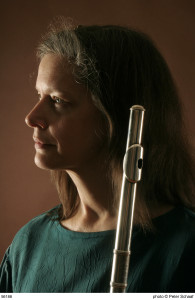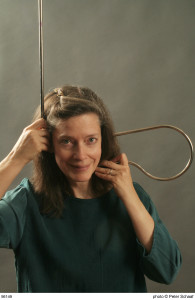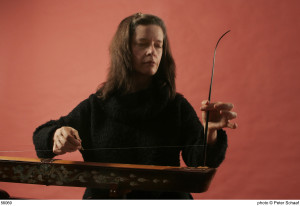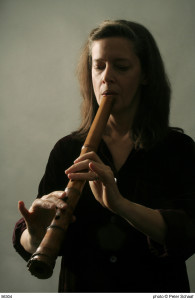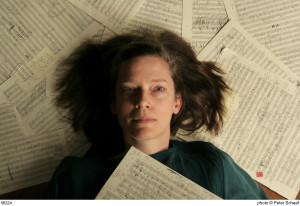Photos
Click on each photo for a high-resolution image. Black and white versions available on request:
Reviews
“… couldn’t write an uncaptivating phrase if she tried.”
– Village Voice
Read Tokafi’s interview with Elizabeth Brown
Read Kyle Gann’s profile in Chamber Music America
Read Molly Sheridan’s profile on NewMusicBox, Slipping through Memory:
Read Brown’s statement on being a self-taught composer on NewMusicBox:
Read what John Hoge of Theremin World has to say about Brown’s theremin music:
Elizabeth Brown: Mirage New World 80751
“…Elizabeth Brown is aptly described in the liner notes of her recent CD Mirage as a ‘gentle maverick.’ Her work is experimental in nature, yet rather than whacking the listener over the head with that, the music has an understated and beautifully handmade feel that begs careful listening and exploration. Brown is a talented flutist as well as a shakuhachi and theremin player, and within the disc’s seven works she performs on those instruments in combination with ensembles that include string quartet, recorded sound, Harry Partch instruments, and Japanese traditional instrument orchestra. The track featured here, Arcana, for flute and recorded sound, is full of bending, melting sounds that suggest a dreamlike tale of intrigue.”
Alexandra Gardner, NewMusicBox
http://www.newmusicbox.org/articles/sounds-heard-blowing-in-the-wind-flute-edition/
“Elizabeth Brown is known for her multi-instrumental talents and unique compositional voice…if you want to find out what one of the most interesting creative musical voices in the US has been up to for the last ten years and fancy escaping convention and seeking out new sounds, then this always intriguing and at times stunningly beautiful set of pieces demands your attention.”
Dominy Clements, Musicweb International
read full review:
http://www.musicweb-international.com/classrev/2013/Aug13/Brown_mirage_807512.htm
“Brown is a ‘gentle maverick.’ Though her music bespeaks an ironclad intelligence and steely will, and evidences ties to all sorts of American experimental traditions, it still desires to give pleasure to performer and listener alike. It is eclectic, but seamlessly so. Its many sources and influences blend into an organic whole that seems to have always been there, but which she fortuitously discovered. Above all, it is personal, the work of an unpretentious, deep, and questing spirit.”
Robert Carl, from the liner notes
Included in Alex Ross’s “New releases of interest”
http://www.therestisnoise.com/2013/08/nightafternight-playlist.html
“Originally a flutist, Brown also plays theremin and shakuhachi, and there are interesting compositions on this CD for all of them. Theremin pieces eerie, dreamy, shakuhachi pieces with that Asian abstract feel.”
Play most!WRUV 90.1 FM of Burlington, Vermonthttp://wruv.wordpress.com/2013/07/21/elizabeth-brown-mirage/
“Otherworldly, ghostlike, yet strangely cheery, the music of Elizabeth Brown mates the theremin, with the guitar, the shakuhachi with the string quartet, ancient Japanese instruments with modern harmonies, and avant-garde gestures with open-hearted songfulness. The result is utterly seductive. This is the most fun I’ve had with contemporary music in a while.Brown projects a 21st Century sensibility that sounds a bit like the Twilight Zone and a bit like early Messaien when he was entranced with the theremin, yet her style is distinctive and original. The pieces have suggestive titles like Arcana, Atlantis, and A Bookmobile for Dreamers. They suggest an otherworldly world, then fade away, sometimes quicker than you want them to. Nothing goes on too long. Shakuhachi, Vietnamese monochord, theremin, diamond marimba, and other exotic instruments create a vibrating delicacy aided by the vivid recording, pulling the listener in. There is a gentle surrealism that makes us feel we are inside Brown’s dreams and that they are mainly happy ones. The most recent piece, An Imagined Landscape (2010), is rather austere and atypical; it offers a contrast to the hallucinated vibrancy of works from earlier in the century like Seahorse and Atlantis. This music is melodic – even childlike, yet the overall effect is adventurous and original. As Robert Carl puts it in the imaginative notes, the avant-gardism is “presented in a sensibility that is tender, sweet, and toy-like; it expresses a genuine innocence, something we encounter far too rarely in an era of postmodern irony”. I for one am a bit tired of postmodern irony; if you feel the same, you should grab this recording.”
Jack Sullivan, American Record Guide
Rural Electrification
Read Molly Sheridan’s review in NewMusicBox
Read Silke Tudor’s review in The Village Voice
Blue Minor: Chamber Music by Elizabeth Brown Troy 627
“Elizabeth Brown is a New York composer who, among other things, is a professional performer on flute and shakuhachi (the Japanese bamboo flute). Her experience as a player informs all her chamber music, which is subtly written, utterly idiomatic, and presented by some of the best freelance musicians in the city. Her aesthetic takes many traditional tropes from the standard repertoire and gently twists and subverts them. The result is genuine lyricism, but heard in a dreamlike state, even a little hallucinatory. There’s a great wit evident, but mercifully no irony; this is music that’s not afraid of beauty, but also refuses easy-listening romanticism.”
– Robert Carl, Fanfare
Wicked, Woozy and Wondrous
One of the joys of listening to music by little-known composers is that sometimes you really luck onto something wonderful. And that is what has happened for me with this CD of some chamber music by Elizabeth Brown; I’d known of her as a flutist, but not as a composer. Music must drip from her finger tips; it all seems inspired in the way that Mozart’s music is inspired, as if it simply flowed out of her. I have no idea how difficult it was for her to write these pieces, but they are so smoothly wrought that it sounds as if she simply served as the music’s vessel.
– J. Scott Morrison
Piranesi
‘The Momenta Quartet has drawn notice for its wide range, championing contemporary work…..Elizabeth Brown’s “Piranesi,” for theremin and strings, wove airy, eerie patterns around stop-motion video art by Lothar Osterburg, who, like the composer, drew inspiration from the fantastical architectural etchings of Giovanni Piranesi. (Brown doubled as thereminist.)’
– Alex Ross, The New Yorker, February 4, 2013
Lost Waltz
Read Bernard Holland’s review in The New York Times
Read the Hartford Advocate article
“Depending on how you look at it, Lost Waltz is either an exercise in wistful nostalgia for a more clearly-ordered past, or a playful jest with conventions of a more recent vintage … it uses the repetitive phrase structure of 20th-century minimalism with a nod to the multitempo constructions of Nancarrow and Carter. Continuity is achieved by overlapping superimpositions of various repetive waltz ideas, each in a different tempo. The effect is something like sitting in an elegant Viennese salon as recreated by Data on the holodeck of the Enterprise as the ship passes through anomalies in the space-time continuum. Susan Nidel, a veteran of New York’s new-music scene, played the prominent flute part with shimmering microtonal inflections that made her music seem to come from another place. A most fascinating work.”
– Ithaca Times
“Brown’s Lost Waltz, which had its world premiere on Monday, suggested a ballroom in Atlantis. Complicated and glittering passages in the winds flitted through swirling eddies of string arpeggios and wavy scales. The piece was a bit like quickly flowing water: attractive, allusive, even poetic.”
– Newsday
Archipelago
“Elizabeth Brown’s Archipelago quite simply blows me away as the gentlest fusillade one is ever likely to hear. For a start, the work appears haynted by the spirit of John Dowland’s Can she excuse my wrongs?, a.k.a. If my complaints could passions move. This is nowhere stated or indeed obvious. It is probably more a question of my wishing it so. Whatever, the hint of a powerfully beautiful melody appears almost immediately on cello, its full fruition borne by cello and flute against the narcotic luminosities of synthesizer, surrogate kithara, diamond marimba, and a pair of Dean Drummond’s zoomoozophones, in a kind of free fantasy assembled with an attention to poetry and detail that plays for me as a beyond-brilliant union of common and uncommon parts.”
– Mike Silverton, Fanfare
Delirium
“…challenged listeners to listen between notes, as did the quieter Delirium by Elizabeth Brown, performed by Newband on Mr. Partch’s instruments. The day’s most beautiful moment involved abstraction transformed into tenderness.”
– Ann Powers, New York Times
Acadia
“… scored for western flute and shakuhachi, Acadia made magical use of the qualities of both instruments. Often, the personalities of the two flutes merged, with the western flute bending eastward in sliding pitches and breathy tones. Both could flash with hard brilliance in sharp, shrill notes. And both could return to their separate modes, their colors heightened by the encounter.”
– Taos Journal
The Memory Palace
“Elizabeth Brown’s Memory Palace (1990) uses a tonally freewheeling language (neither strictly rooted nor fully atonal) and an abstract structure to paint a distinct, if fanciful, picture in which thematic relationships come increasingly into focus as the piece unfolds.”
– Allan Kozinn, New York Times
“The Memory Palace, for flute, cello, and piano, impressed for its cool, sustained architecture – emerging from ascending stepwise patterns, but immediately freezing any forward motion in a suspension of recollected memories.”
– Los Angeles Times
Migration
“… the music that left the strongest and most lasting impression was Elizabeth Brown’s Migration … The sonic landscape is generally spare and concrete, emphasizing sound in itself, and it unfolds in a sort of dreamlike slow motion that recalls thaditional Japanese music and theater. But the music also keeps one foot in the European tradition of melody and functional harmony, though without a clear tonal center. The result is music that is at once familiar and alien, constantly changing but consistently magical.”
– San Antonio Express-News
“Elizabeth Brown combined a shakuhachi with string trio in a delicate texture that reminded me, improbably, of Mozart’s flute quartets.”
– San Francisco Chronicle
Catalog of Scents in the Garden at Night
Read the Vail Daily article
Travelogue
Innova 556
“Composer-flautist Elizabeth Brown weaves a potentially frightening microtonal vocabulary into pure innocence.”
– Grammophon
In a Dreamt Landscape
“… a tantalizingly brief exploration scored for western and Native American flute, harp, and string quartet, it pulled the listener into a fleeting, flickering world as haunting as a dream can be. Agitated measures with rapid string motifs and sharp outbursts reminiscent of birdsong from the western flute alternated with with passages of heightened calm from the Native American flute. Fragments dissolving in sliding pitches and sudden shifts conveyed the beguiling illogic of dreams.”
– Taos Journal
The Secret Life of Birds
“Brown’s evocative piece proved the surprise hit of the evening. The blend of Western flute and Japanese koto supplied arresting sonorities. The composer is an inveterate birdwatcher and an adapt on the shakuhachi, a close cousin to our flute. She tuned the 13 strings of the koto in a traditional manner, shifting the top seven a half step up. But it’s the flute line, with its slides, chirps and warbles that arrests the ear.”
– San Francisco Examiner
A Certain Light, from The Aids Quilt Songbook
“The music was quiet, hypnotic, and plaintive, the moment of respite as heartrending as the nightmare.”
– New York Native
Collected Visions
“… both sweetly innocent and foreboding.”
– The Houston Post
Orrery
“The word denotes an apparatus for measuring the planets, and the music suggested an immense serenity within tiny gears. Orrery also breathed a fresh, nonprimitive lyricism. No one banged a can at this dream of a work.”
– Leighton Kerner, Village Voice
Augury
“…Elizabeth Brown’s mystical “Augury” (1987), a quirky five-movement work for flute and guitar. Each movement musically represents a different method of fortune-telling, inventively mixing various guitar effects and a simple tonal language with a few dissonances added for spice.”
– Greg Wager, Los Angeles Times
